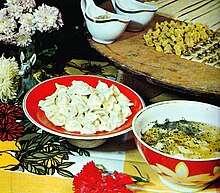Joshpara
Joshpara is a kind of dumpling popular in Central Asia, South Caucasus and the Middle East. They are made of unleavened wheat dough squares filled with ground meat and condiments.[1] In observance of the Islamic dietary rules, the meat filling is usually without pork.
Etymology
Josh means "to boil" while para is a term for "bit" in early Persian.
Another theory about the words' etymology is that the word comes from the Turkic word düşbərə. The words tosh and dash mean "filled up" and "spill out", and berek means "food" (dishes made from dough). This alludes to the fact that düşbərə should be added in when the water is boiling and spilling out of the saucepan.[3]
A common Azerbaijani joke suggests that the word comes from “düş bəri”, which means "fall here": in other words, asking to fill the spoon with as many dumplings as possible.[3]
Regional variations
Turkic and Persian cuisines
The dish is found in Azerbaijani, Iranian, Tajik, Uzbek, Uyghur, and other Central Asian cuisines.[1][4][5]

The dough for Central Asian chuchvara or tushbera is made with

In Azerbaijan, the dumplings are smaller and the dough is thicker.[4] Düşbərə are typically made from dough (wheat flour, egg, water), mutton (boneless), onions, vinegar, dried mint, pepper, and salt. The dish is prepared either with water or meat broth. Mutton can be substituted with beef, or even with chicken.[3] The broth is made from mutton bones, and the ground meat is prepared with onions and spices. The dough is then rolled, cut into small squares, and stuffed with ground meat. The squares are wrapped like triangles and the edges are pasted together, making shell-shaped figures. The dumplings are added into the boiling salty water and cooked until the dumplings come to the surface.[3][6] Düşbərə are served with sprinkled dried mint. Vinegar mixed with shredded garlic is added or served separately to taste.[3] 5-8 düşbərəs typically fit on a spoon; however, in rural areas of Absheron, they are made small enough that a spoon can hold as many as 20.[3]
Arab cuisines

Shishbarak is prepared in Iraq, Jordan, Lebanon, Palestine, Syria, Hejaz, and the northern area of Saudi Arabia.[7] After being stuffed with ground beef and spices, thin dough parcels are cooked in yogurt and served hot in their sauce.[8] A part of Arab cuisine for centuries, a recipe for shushbarak appears in the 15th century Arabic cookbook from Damascus, Kitab al-tibakha.[2]
Related dishes
- Mantiis another type of dumpling popular in Central and West Asia.
See also
References
- ^ ISBN 9780199677337.
- ^ ISBN 9780970971685
- ^ ISBN 978-9952-486-00-1.
- ^ a b Mar (2019). "The Best Azerbaijan Food". Once in a Lifetime Journey.
- ^ a b D. Rahimov, ed. (2017). "6. Traditional Food". Intangible Cultural Heritage in Tajikistan (PDF). Dushanbe: R-graph Publisher House.
- ^ Ahmedov, Ahmed-Jabir (1986). Azərbaycan kulinariyası, Азербайджанская кулинария, Azerbaijan Cookery - cookbook, in Azeri, Russian & English. Baku: Ishig. p. 40.
- ISBN 9780740770432
- ISBN 9780781811903
External links
- AZ Cookbook
- Chuchvara in Uzbek cuisine (with a photograph)
